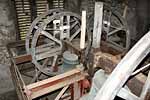 Collingham Collingham
All Saints
Bells
Wake (1867) mentions four bells:
 The oldest cast in 1613 was inscribed Sweetly toling men do call. To taste meate that feeds the sole. The oldest cast in 1613 was inscribed Sweetly toling men do call. To taste meate that feeds the sole.
 The bell on the east side of the tower was the second heaviest; it was inscribed 1661 with the motto Jesus be our Speed. The bell on the east side of the tower was the second heaviest; it was inscribed 1661 with the motto Jesus be our Speed.
 To the west was the largest bell (tenor), said to weigh 18 cwt it was installed in 1715 and is inscribed Haec Campana fiat sacra Trinitate beatâ. To the west was the largest bell (tenor), said to weigh 18 cwt it was installed in 1715 and is inscribed Haec Campana fiat sacra Trinitate beatâ.
 The smallest bell (treble) was to the north inscribed Charles Lestier, Wm M Dewick, Ch: Wardens; Thomas Osborne, Dowhnam Norfolk, fecit 1797 The smallest bell (treble) was to the north inscribed Charles Lestier, Wm M Dewick, Ch: Wardens; Thomas Osborne, Dowhnam Norfolk, fecit 1797
On 14 November 1921 the vicar, the Rev A Gould, and the churchwardens, wrote to the Bishop of Southwell, to say that the old timber framework was in a dangerous condition and, as a result, except for chiming, the bells and not been rung for the past six years. The bells were out of tune, one cracked and the fittings old and decayed. The estimated cost of required works was £531 plus the cost of some work to pulleys, local masons work and cartage from the station.
However, on 28 November 1921, Arthur Loveday of Collingham, architect and churchwarden, wrote similarly, to say that ‘the tower is amply strong to bear the strain of the additional bells’. A faculty was then issued for restoring the existing bells and adding two new bells ‘to construct a steel frame with new fittings throughout the belfry and to recast one bell and return the other three bells. To add two new bells to form a peal of 6. To take away from the ground floor at the west end 4 short seats each accommodating 3 persons and to enclose the ringing chamber by an oak screen across the tower arch.'
Following a petition on 3 January 1922 a faculty was issued for restoring the existing, and adding 2 new, bells in the belfry … 'to construct a steel frame with new fittings throughout the belfry and to recast one bell and retune the other three bells. To add two new bells to form a peal of 6. To take away from the ground floor at the West end 4 short seats each accommodating 3 persons and to enclose the ringing chamber by an oak screen across the tower arch – provided that the design of the screen is submitted and approved by the Vicar-General”. Invoice from Gillet and Johnston ‘Tower, Electric and House Clock bells and carillons (Croydon) Ltd’ to:
Supply frame for 6 bells and new fittings for 4 old bells
Supply new treble bell with fittings (£70) – inscription; 53 letters at 6d
Supply new 2nd bell with fittings (£78) inscription ; 58 letters at 6d
Repair clock hammers etc (£15)
Recast tenor bell and reproduce inscription (£48).
Most of the Bell Founder Gillett and Johnsons' records were lost during World War Two. However, they have confirmed that it was standard practice to recast new bells from the old bells of the same church.
The oak screen for the tower arch was designed by W.H. Wood, architect of Newcastle upon Tyne, to read ‘To the Glory of God and in Honoured Memory of the men of Collingham who laid down their lives in the great war 1914-1920. Grant them eternal rest O Lord.’ The inscription was quoted in the faculty application but never implemented.
| |
Inscription |
Size |
Weight |
| 1 |
GILLETT AND JOHNSTON. CROYDEN (G)
THE GIFT OF ORLANDO AND MABLE KEYWORTH
1922
O COME - LET US WORSHIP |
26.25" |
3-2-19 |
| 2 |
TO THE MEMORY OF ELIZABETH KIRK
THE GIFT OF HER DAUGHTERS 1922
LAUS DEO |
28.50" |
4-2-2 |
| 3 |
CHARLES LESTER:W DEWICK C.WARDNES :
THO. OSBORN DOWNHAM NORFOLK FECIT 1792 |
31.25" |
5-1-19 |
| 4 |
JESUS BEE OUR SPEED 1661
THIS BELL WAS RECAST 1922 |
33.00" |
6-3-19 |
| 5 |
I SWEETLY TOILING MEN DO CALL TO TASTE
ON MEATS THAT FEEDS THE SOOLE 1613 |
35.00" |
7-0-0 |
6 |
HAEC CAMPANA SACRA FIAT TRINITATE BEATA 1715
ANTH. AYRE: THO. MILLS WARDENS
THIS BELL WAS RECAST 1922 |
38.94" |
9-3-4 |
 The treble, 2nd, 4th, and tenor are by Gillett and Johnston 1922. The 3rd is the work of Thomas Osborn, and the 5th is by Henry II Oldfield. The treble, 2nd, 4th, and tenor are by Gillett and Johnston 1922. The 3rd is the work of Thomas Osborn, and the 5th is by Henry II Oldfield.
In 1552 there were three bells recorded.
The frame is a fabricated steel frame by Gillett and Johnston dating from 1922.
|